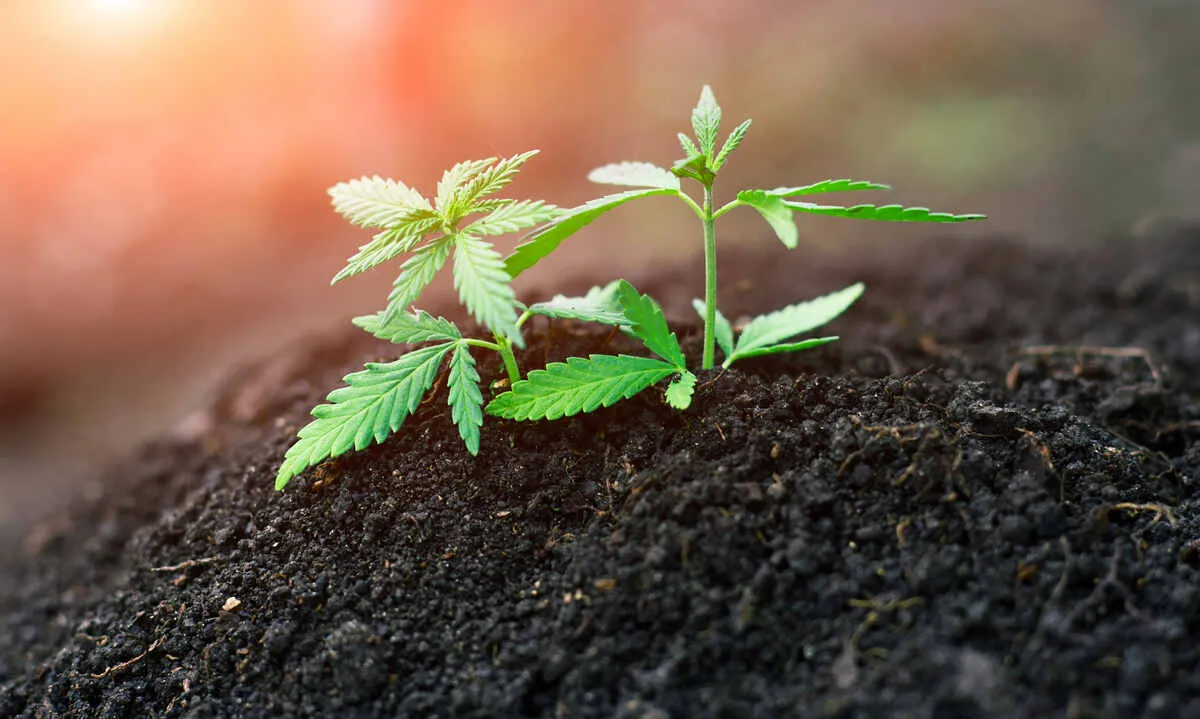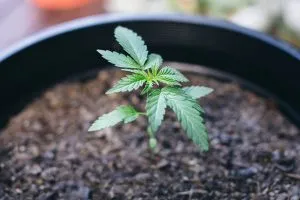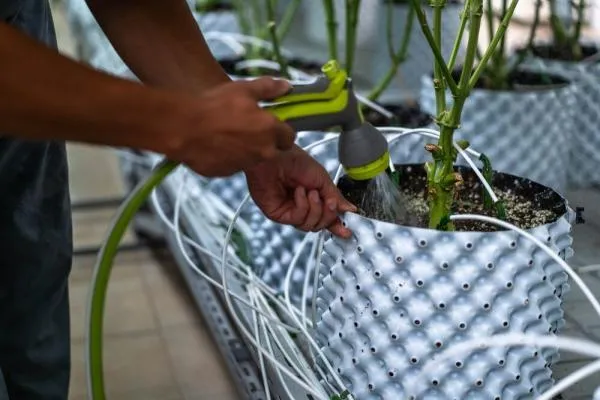When you grow cannabis you’ve got to nourish to flourish, and it all begins with the roots or base of your plants. Soil is by far the most popular growing medium for weed, and it is ideal for beginners. However, not all soil is the same and so choosing the right type for your grow is key to achieving big healthy harvests. So, what is the best soil for growing weed? Let’s take a look at the pros and cons of growing with soil and what ingredients go into making a great soil for cannabis.
- The Pro’s and Con’s of Growing in Soil
- Pro's of growing with soil
- Con's of growing with soil
- What makes a good soil for cannabis?
- What are the different types of soil?
- Soil Additives to Consider
- Photoperiod Plants vs. Autoflowering
- What is the best diy cannabis soil?
- Is potting soil okay for weed?
- Can you grow weed using no synthetic nutrients?
- Is soil of coco coir better for growing weed?
- Can you mix coco coir and soil?
- Soil Matters for Growth
The Pro’s and Con’s of Growing in Soil

With the emergence of hydroponic systems, many cannabis growers are now asking - to grow in soil, or not to grow in soil? Like many of the factors that go into growing healthy marijuana plants, your soil is just another that will be just as important to choose. Of course, there are pro’s and con’s of going with cannabis soil as a growing medium, so we’ve compiled a simple breakdown to best understand.
Pro's of growing with soil
- Forgiving: Soil offers a buffer against nutrient imbalances and pH fluctuations, which provides a more forgiving environment for novice growers.
- Natural environment: Cannabis grows naturally in soil all around the world and for those that want to grow completely organically it is the best option.
- Rich in nutrients: Good quality organic soil provides a good mixture of nitrogen, phosphorus and potassium all of which support healthy plant growth.
- Sustainable: Soil is an environmentally friendly and renewable resource.
- Cheap: Soil is cheap and available from any garden centre or if you are lucky enough you may have a good source in your back garden.
Con's of growing with soil
- Slower growth: Cannabis plants generally grow more slowly in soil compared to other media, such as coco coir or hydroponics.
- Pests and diseases: Soil can harbor pests and pathogens, which may require more proactive measures to prevent and treat.
- Less control: Growing in soil offers less precise control over nutrient availability and pH levels, which may impact overall yield and potency.
What makes a good soil for cannabis?

A good cannabis soil needs to have several qualities to promote healthy plant growth. These include:
- A balanced of nutrients: All good soils should contain the right balance of essential nutrients, these are nitrogen, phosphorus, and potassium, to support robust vegetative growth and flowering.
- Optimal pH Level: Cannabis plants thrive in slightly acidic soil, with a pH level between 6.0 and 7.0. This range allows the plants to absorb nutrients effectively.
- Proper Aeration: Healthy root growth requires good aeration in the soil. Well-aerated soil provides oxygen to the roots and allows for proper drainage, preventing issues like root rot.
- Good Drainage: Excessive water retention can cause a myriad of issues, from root rot to nutrient lockout. A good soil should have adequate drainage to prevent such problems.
- Water Retention: Although soil must offer good drainage, you don't want it to drain right through, so having a healthy balance of water retention and drainage is key.
What are the different types of soil?
Once you decide to cultivate using soil, that’s not the last decision you’ll have to make. Then, it’s time to choose what type of soil is best for your operation or the growth you’re trying to achieve. Luckily, over the years, the growing community has learned what works and what doesn’t. So, using this knowledge can help boost success from the start. The most popular types or textures of soil include:
- Sandy soils: Sandy soils contain lower levels of pH which will help you along the way when balancing pH for nutrient uptake. Higher oxygen levels also make sandy soils, helpful for optimal growth. The granules are larger so sandy soils also help promote proper drainage and avoids compactness. On the flip side, better drainage means less water retention and can lead to sandy soils drying out more quickly than others.
- Silt soils: Silt soils have a smaller granular size compared to sandy, so conversely it retains water better, with less than ideal drainage. But it naturally contains beneficial nutrients which can help stabilize plants for a more healthy growing environment.
- Clay soils: Clay soils are the smallest in granular size in comparison to sandy, and silt, but comes with a higher pH level than most. Its consistency may be hard to work with, but the material has a high level of beneficial minerals that promote healthy growth. Again, like silt, it retains water better than sandy soils, yet lacks in drainage.
- Loam soils: So, what happens when you combine soil types to benefit from the varying types’ of individual advantages? That’s the purpose of loam soil. Cannabis plants flourish with mixed materials like loam soils provide. Due to the soil’s neutral pH levels, fertile nature, high oxygen levels, and ideal drainage and retention. The only downside is loam soils can be more expensive in cost.
Soil Additives to Consider
After you’ve decided which soil to purchase, if it’s not a combination made specifically for growing weed - you can easily add materials to improve the base’s quality. Soil additives can improve drainage, increase water retention and the uptake of nutrients for optimal growth. The most popular items to add to soil, to do so are:
Perlite
Perlite is white pebbles in varying size, that feel like Styrofoam in consistency. When adding to soil, they help improve overall texture by better holding water and air. Perlite also helps improve drainage when using 10-20% in your soil mix.
Coco Coir
Coco Coir is a unique material that’s made of coconut husks. The consistency helps promote ideal water retention without causing the soil to become too heavy. Coco Coir’s biggest advantage is it helps the root of your plants develop more quickly. It is possible to grow your plants in strictly coco coir, but the soil can be costly. If creating a blend of soils, it’s recommended to add up to 30% of your final mixture.
Vermiculite
Vermiculite is often used with perlite are similar in shape and color. The additive lightens the weight of the soil, while improving water retention.
Clay Pebbles
Clay Pebbles while often used with hydroponics, can also be added to your growing containers for unique benefits, too. Most growers place clay pebbles at the bottom base of their cannabis soil, which prevents water from pooling. This enhances overall drainage and avoids root rot that can occur from poor drainage. Other growers add clay pebbles to the top of their soil mix, to trap moisture that would normally escape through evaporation. On top, clay pebbles also serve as ‘mulch’ hindering weed growth and protecting beneficial nutrients from hot sun or lights.
Worm Castings
Worm castings...or, yes, worm ‘poop’ is a highly beneficial soil additive used by a variety of gardeners and growers. It can help cannabis soil by enhancing the overall texture for better water retention and drainage. Worm castings, and other ‘icky’ materials like manure or compost naturally also contain beneficial nutrients like phosphorus, potassium, and nitrogen that slowly release over time.
Photoperiod Plants vs. Autoflowering
Of course, keep in mind that photoperiod weed will require differing soil content versus autoflowering plants. That’s because autoflowers require fewer nutrients overall for optimal growth. Plus, autoflowers are more finicky to stress, and high levels of nutrients can actually burn the seedling or early veg plants.
When mixing soil for autoflowers, an ideal mix to implement would be -
- 3 parts peat moss
- 3 parts compost
- 2 parts perlite or coco coir
- 1 part vermiculite
What is the best diy cannabis soil?
There are many viable options for purchasing a ready-made mix of soil, specifically formulated for cannabis. But, when you make your own you can pick and choose which factors are most important to the health of your crops. If you’re looking to experiment with mixing your own soil, below is a simple base of ingredients you can follow for success.
Making your Own Cannabis Soil Ingredients -
- 1 part potting soil – a high quality soil for the base, is recommended.
- 1 part compost – you can purchase compost or make your own at home. Adding worm castings with your compost is highly beneficial, too.
- 1 part perlite or coco coir
- 1 part vermiculite
Is potting soil okay for weed?
Yes, potting soil can be used to grow weed, providing it offers good drainage, decent water retention and is light and airy and has a suitable pH level. Most good quality potting soils will be rich in organic matter providing a balanced mix of nutrients. Look for potting soil that is specifically designed for growing cannabis or other similar plants, as these blends are more likely to provide the appropriate conditions for a successful harvest.
Can you grow weed using no synthetic nutrients?
Yes, you can grow weed using just organic soil. Providing the soil you choose offers all of the key qualities we have discussed. Many growers actually prefer the taste of weed that has been grown organically.
Organic living soil contains a wide range of nutrients, including macronutrients like nitrogen, phosphorus, and potassium, as well as micronutrients like iron, zinc, and manganese. These nutrients are slowly released into the soil over time as the organic matter breaks down, providing a steady supply of nutrients to the plants.
The downside to growing 100% organically is that cannabis plants will grow slower. However, to further enhance the nutrient content of the soil, organic amendments such as compost, worm castings, bone meal, and blood meal can be added. These amendments not only provide nutrients but also improve soil structure and microbial activity, which can help the plants to grow.
Is soil of coco coir better for growing weed?
Both soil and coco coir (coco) are commonly used to grow weed, but which is more suited? Well, both offer their own advantages and disadvantages for growing weed. Here's a quick comparison:
Soil:
- More forgiving and natural growing medium.
- Rich in organic nutrients.
- Sustainable and environmentally friendly.
Coco:
- Faster growth rates and potentially higher yields.
- More control over nutrient availability and pH levels
- Lower risk of pests and diseases
Ultimately, the choice between soil and coco will depend on your personal preferences and growing experience. If you're a beginner, you may find soil more forgiving, while experienced growers may prefer the level of control coco offers.
Can you mix coco coir and soil?
As for mixing coco and soil, that can be a good option as coco coir (made from coconut husks) can improve soil drainage and aeration while also providing some nutrient content. However, it's important to make sure the ratio is correct - too much coco coir can cause the soil to become too dry, while too little can lead to soil compaction. A common ratio is 70% soil and 30% coco coir, but it may vary depending on the specific soil and coco coir products you are using.
Soil Matters for Growth
Overall, once you understand the in’s and out’s of how growing in soil works - it’s by far, the easiest and highly effective grow medium to implement. With the information you’ve gained today, now you can start your crop off on the right foot, with the best soils for growing weed. The more you learn about the factors and environments that can affect your operation, the better your plants can thrive.











I grew in bubble buckets for years and believe me, as anyone who has this process down will tell you, got some massive yields. But, eventually I started feeling really guilty about the 35 gallons or so of spent chemicals I was dumping into my toilet every week and what impact that might be having on our water treatment plants.
So, I got several Earth Boxes, several bags of Sohum Living Soil and followed some general guidelines around creating a natural growing environment indoors. I am on my 7th grow with the same soil. Between grows, simply re-amend the soil, plant the new seedlings and, boom, off they go. All I do is water through the tube every 10 days with 1 gallon of bokashi tea made from my own food scraps in a fermenter. No trimming, no shaping, no defoliating, no pests.
Granted, my yields are about 1/2 or so of what I was getting in hydro. But, as a home grower with no business interest, my yields are more than enough to keep us stocked. And the quality of the smoke is inarguably much, much better.
MSNL